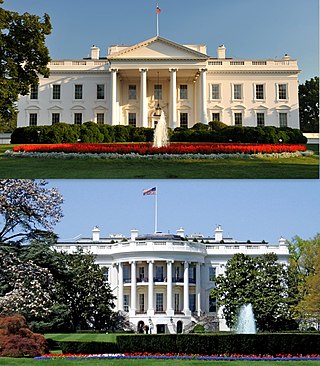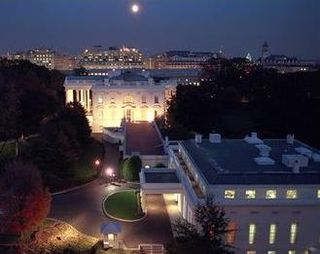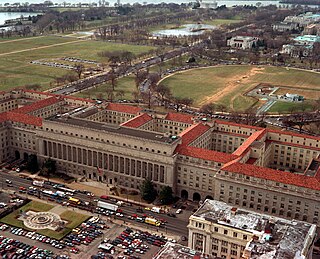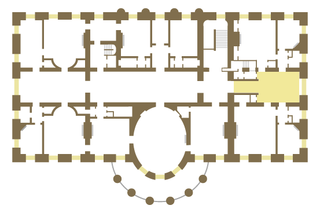
The White House is the official residence and workplace of the president of the United States. It is located at 1600 Pennsylvania Avenue NW in Washington, D.C., and has been the residence of every U.S. president since John Adams in 1800 when the national capital was moved from Philadelphia to Washington, D.C. The term "White House" is often used as metonymy for the president and his advisers.

Edith Kermit Roosevelt was the second wife of President Theodore Roosevelt and the first lady of the United States from 1901 to 1909. She also was the second lady of the United States prior to that in 1901. Roosevelt was the first First Lady to employ a full-time, salaried social secretary. Her tenure resulted in the creation of an official staff and her formal dinners and ceremonial processions served to elevate the position of First Lady.

The West Wing of the White House houses the offices of the president of the United States. The West Wing contains the Oval Office, the Cabinet Room, the Situation Room, and the Roosevelt Room.

The Victor Emmanuel II National Monument, also known as Vittoriano or Altare della Patria, is a large national monument built between 1885 and 1935 to honour Victor Emmanuel II, the first king of a unified Italy, in Rome, Italy. It occupies a site between the Piazza Venezia and the Capitoline Hill. The monument was realized by Giuseppe Sacconi.

The Idaho State Capitol in Boise is the home of the government of the U.S. state of Idaho. Although Lewiston briefly served as Idaho's capital from the formation of Idaho Territory in 1863, the territorial legislature moved it to Boise on December 24, 1864.

Leeds General Infirmary, also known as the LGI, is a large teaching hospital based in the centre of Leeds, West Yorkshire, England, and is part of the Leeds Teaching Hospitals NHS Trust. Its previous name The General Infirmary at Leeds is still sometimes used.

The James S. Brady Press Briefing Room is a small theater in the West Wing of the White House where the White House press secretary gives briefings to the news media and the president of the United States sometimes addresses the press and the nation. It is located between the workspace assigned to the White House press corps and the office of the press secretary.

The Treaty Room is located on the second floor of the White House, the official residence of the president of the United States. The room is a part of the first family's private apartments and is used as a study by the president.

The Executive Residence is the central building of the White House complex located between the East Wing and West Wing. It is the most recognizable part of the complex, being the actual "house" part of the White House. This central building, first constructed from 1792 to 1800, is home to the president of the United States and the first family. The Executive Residence primarily occupies four floors: the Ground Floor, the State Floor, the Second Floor, and the Third Floor. A two-story sub-basement with mezzanine, created during the 1948–1952 Truman reconstruction, is used for HVAC and mechanical systems, storage, and service areas.

The Office of the First Lady (OFL) is the staff accountable to the first lady of the United States. The office and its responsibilities, while not constitutionally mandated, have grown as the role of the first lady has grown and formalized through the history of the United States. The Office of the First Lady is an entity of the White House Office, part of the Executive Office of the President. It is located in the East Wing.

The Herbert C. Hoover Building is the Washington, D.C. headquarters of the United States Department of Commerce.

The Grand Staircase is the chief stairway connecting the State Floor and the Second Floor of the White House, the official home of the president of the United States. The stairway is primarily used for a ceremony called the Presidential Entrance March. The present Grand Staircase, the fourth staircase occupying the same general space, was completed in 1952 as a part of the Truman White House reconstruction. The Grand Staircase is entered on the State Floor from the Entrance Hall.

The South Lawn at the White House in Washington, D.C., is directly south of the house and is bordered on the east by East Executive Drive and the Treasury Building, on the west by West Executive Drive and the Old Executive Office Building, and along its curved southern perimeter by South Executive Drive and a large circular public lawn called The Ellipse.

The East Sitting Hall is located on the second floor of the White House, home of the president of the United States. First used as a reception room for guests of the president, it is now a family parlor with access to the east rooms on the second floor.

The West Sitting Hall is located on the second floor of the White House, home of the president of the United States. The room is entered from the second floor Center Hall on the east side of the room. The room features a large lunette window on the west wall looks out upon the West Colonnade, the West Wing, and the Old Executive Office Building. The room is used by first families as a less formal living room than the Yellow Oval Room.

Roosevelt Hall (1903–1907) is an immense Beaux Arts-style building housing the National War College on Fort Lesley J. McNair, Washington, DC, USA. The original home of the Army War College (1907–1946), it is now designated a National Historical Landmark (1972) and listed on the National Register of Historic Places (1972).

The Pentagon is the headquarters building of the United States Department of Defense, in Arlington County, Virginia, across the Potomac River from Washington, D.C. It was constructed on an accelerated schedule during World War II. As a symbol of the U.S. military, the phrase The Pentagon is often used as a metonym for the Department of Defense and its leadership.
The Secretary to the President was a 19th- and early 20th-century White House position that carried out all the tasks now spread throughout the modern White House Office. The Secretary would act as a buffer between the president and the public, keeping the president's schedules and appointments, managing his correspondence, managing the staff, communicating to the press as well as being a close aide and advisor to the president in a manner that often required great skill and discretion. In terms of rank it is a precursor to the modern White House Chief of Staff.

The desk in the Vice President's Ceremonial Office in the Eisenhower Executive Office Building, colloquially known as the Theodore Roosevelt desk, is a large mahogany pedestal desk in the collection of the White House. It is the first of six desks that have been used by U.S. presidents in the Oval Office, and since 1961 has been the used as the desk of the U.S. Vice President.

Villa Maria Hostel is a heritage-listed nursing home at 167-173 Saint Paul's Terrace, Fortitude Valley, City of Brisbane, Queensland, Australia. It was designed by Frank Cullen, Hennessy, Hennessy, Keesing & Co, & J P Donoghue and built from 1927 to 1968. It was added to the Queensland Heritage Register on 18 September 2008.
























